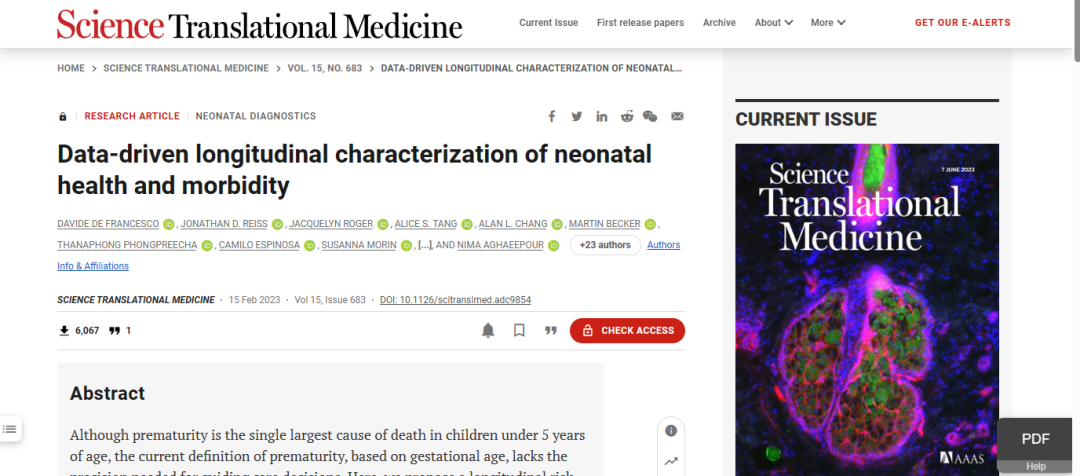来自Science的科研成果

来自美国的各研究机构的科学家们提出了基于深度学习模型的新生儿不良结局的纵向风险评估,该模型用来预测新生儿从受孕到出生后一段时间内的各种结果。
Although prematurity is the single largest cause of death in children under 5 years of age, the current definition of prematurity, based on gestational age, lacks the precision needed for guiding care decisions. Here, we propose a longitudinal risk assessment for adverse neonatal outcomes in newborns based on a deep learning model that uses electronic health records (EHRs) to predict a wide range of outcomes over a period starting shortly before conception and ending months after birth. By linking the EHRs of the Lucile Packard Children’s Hospital and the Stanford Healthcare Adult Hospital, we developed a cohort of 22,104 mother-newborn dyads delivered between 2014 and 2018. Maternal and newborn EHRs were extracted and used to train a multi-input multitask deep learning model, featuring a long short-term memory neural network, to predict 24 different neonatal outcomes. An additional cohort of 10,250 mother-newborn dyads delivered at the same Stanford Hospitals from 2019 to September 2020 was used to validate the model. Areas under the receiver operating characteristic curve at delivery exceeded 0.9 for 10 of the 24 neonatal outcomes considered and were between 0.8 and 0.9 for 7 additional outcomes. Moreover, comprehensive association analysis identified multiple known associations between various maternal and neonatal features and specific neonatal outcomes. This study used linked EHRs from more than 30,000 mother-newborn dyads and would serve as a resource for the investigation and prediction of neonatal outcomes. An interactive website is available for independent investigators to leverage this unique dataset: https://maternal-child-health-associations.shinyapps.io/shiny_app/.
研究发现:
尽管早产是5岁以下儿童死亡的主要原因,但基于胎龄的当前早产定义缺乏指导护理决策所需的精确性。在这里,研究人员提出了一种基于深度学习模型的新生儿不良预后的纵向风险评估方法,该模型利用电子健康记录(EHRs)在从受孕前不久开始到出生几个月后的时间段内预测各种结果。通过链接Lucile Packard儿童医院和斯坦福医疗成人医院的EHRs,他们建立了一个2014年至2018年间诞生的22,104对母婴,提取并使用了母婴的EHRs来训练一个多输入多任务的深度学习模型,其中包括了一个长短期记忆神经网络,用于预测24种不同的新生儿结果。
另外,他们利用了2019年至2020年9月间在同一斯坦福医院分娩的10,250对母婴作为验证模型的附加队列。对于考虑的24种新生儿结果,交付时的接受者操作特征曲线下面积超过0.9,并且在其他7种结果中介于0.8和0.9之间。此外,综合关联分析确定了多个已知的母婴特征与特定新生儿结果之间的关联。本研究使用了超过30,000对母婴的链接EHRs,并将成为研究和预测新生儿结果的资源。独立研究人员可以使用交互式网站利用这个独特的数据集:https://maternal-child-health-associations.shinyapps.io/shiny_app/。
原文链接: https://www.science.org/doi/10.1126/scitranslmed.adc9854 通讯作者: *文章仅做分享交流使用,版权原作者所有,侵删。Davide De Francesco,Jonathan D. Reiss,Jacquelyn Roger ,Alice S. Tang ,Alan L. Chang,Martin Becker,Thanaphong Phongpreecha,Camilo Espinosa,Susanna Morin ,Eloise Berson,Melan Thuraiappah,Brian L. Le,Seyedeh Neelufar Payrovnaziri,Samson Mataraso,Yeasul Kim,Lei Xue,Melissa G. Rosenstein,Tomiko Oskotsky,lvana Maric,Brice Gaudilliere,Brendan Carvalho,Brian T Bateman,Martin S. Angst,Lawrence S. Prince,Yair J. Blumenfeld,William E. Benitz,Janene H. Fuerch,Gary M. Shaw,Karl G. Sylvester,David K. Stevenson,Marina Sirota,Nima Aghaeepour.